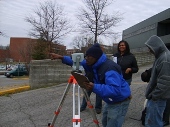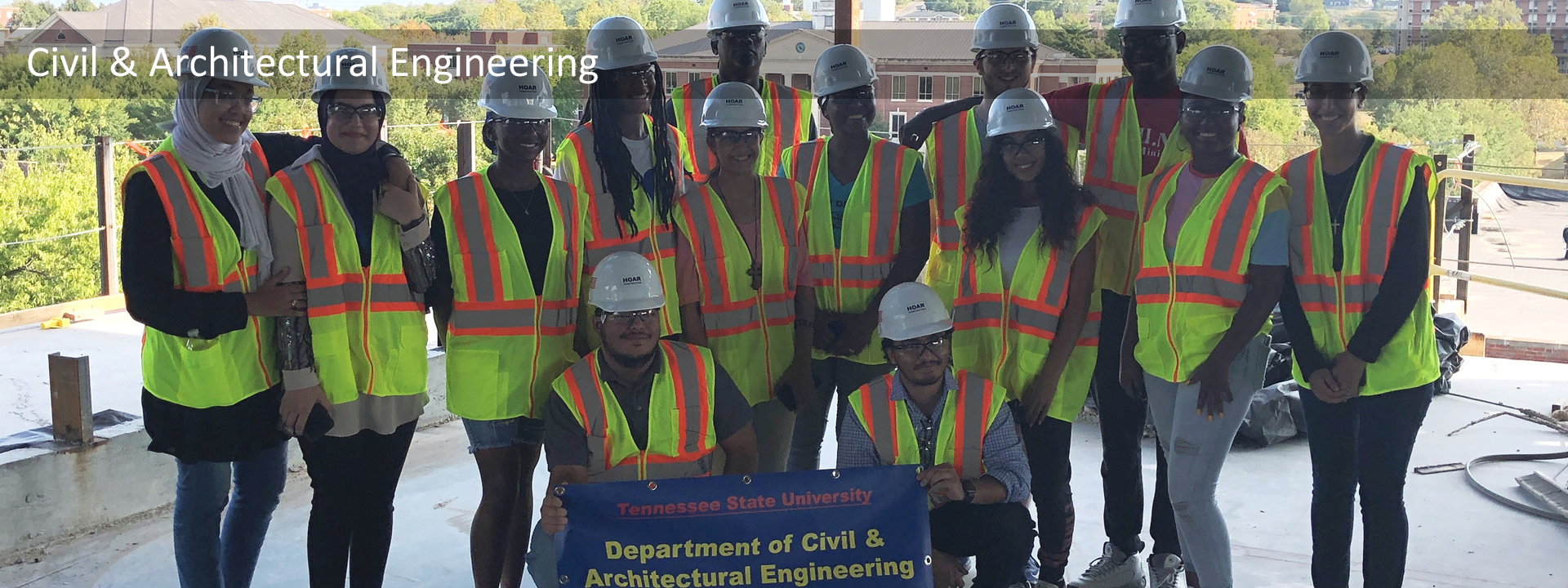- Home >
- Civil Engineering
- > Laboratories
Laboratories
Civil & Architectural Engineering
Architectural Labs
The four instructional laboratories include:
ET 225 - The senior design lab is considered a non-instruction lab and is used exclusively for seniors engaged in senior projects and other design work. The lab is divided into 12 workstation cubicles. The equipment in this lab consists of computers, printer/plotters, and a scanner. In addition, each workstation is equipped with a layout / drafting table. Software packages are included for architectural engineering designs.

ET 227 – This lab is used for basic computer graphics and intermediate computer graphics and design. It houses 20 computers with dual monitors and two HP Plotters for students to use to do homework and to access the Internet. The computers are loaded with all the teaching software packages that the Department has so that the students can use them at all times. The lab is open all day long and a work-study student is on duty to provide computer assistance. The software used in this lab include Revit, SketchUp, ETABS, CSiBridge, CSiXRevit, spbeam, and spcolumn, etc. This lab is used for ENGR 1151 Computer for Engineering Graphics, AREN 1111 Architectural Graphics, AREN 2011, AREN 3021 Architectural Design I/II.

ET 244 – This building system simulation lab is used for design experience of mechanical systems, including HVAC and power system for Architectural Engineering Students. The laboratory is equipped with the state-of-the-art equipment used to teach mechanical and structural systems of buildings and to conduct research. The lab is equipped with Environmental Application System Amatrol T7083, Thermal System Amatrol T7082, Structural System Amatrol T9004, Power Distribution System, Quanser Shaker, Applied Thermal Science Amatrol T7081, Building Management Trainer (Hampden H-MZBM-T1B), etc. This lab is used for the mechanical system courses, such as MEEN 4200 Heating & Air Conditioning, AREN 4430 Lighting/Power Systems.

ET 248 – This 3D AR lab is used for design experience of Architectural Engineering Students with Augmented Reality (AR) and 3D Printers. AR sets (HTC VIVE Pro) and 3D Printers are incorporated into advanced architectural engineering design courses, such as AREN 3410 Structural Analysis, AREN 3440 Steel Design, AREN 3420 Reinforced Concrete Design, AREN 3460 Wood and Masonry Design, AREN 4220 Advanced Mechanical Systems and AREN 4450 Energy Conservation.

Environmental Laboratory
The Environmental Laboratory is primarily focused on chemical analysis of surface and groundwater samples. The students will gain a basic understanding of the chemical, physical and biological principles associated with environmental analysis. They develop hands-on competency with equipment, apparatus, and instrumentation used for water analysis in the field and environmental laboratory. Students help collect samples and then run various analysis (specific conductance, pH, temperature, alkalinity, hardness, metals, BOD, COD, bacteria, volatile organic compounds). During this process, they also learn about lab safety and QA/QC procedures. The Good Lab Practices (GLP) the students learn in this course transfer to all other types of lab procedures, such as air monitoring or wastewater analysis. Students that pass this course are more competent and confident in the field of environmental engineering.

Fluids Laboratory
The fluids laboratory is equipped to test and verify some of the principles of fluid flow. In engineering applications, fluids either flow in open passages (channels) or closed passages (pipes). Hence fluid laboratory tests incorporate open channel models as well as pipe models. Besides verification of certain theoretical relations, tests are also used to determine characteristic coefficients associated with measuring instruments. Major equipment in the fluids laboratory include two hydraulic benches, a full size hydraulic demonstration channel and an airflow testing system.

Mechanics of Materials Laboratory
The Materials Testing Laboratory is on the first floor with a floor space of 1000 ft2. There are bulk material storage bins for coarse and fine aggregates, benches with power outlets, compressed air and vacuum nozzles, sinks, a storage cabinet, a safety shower and eyewash and Internet access. The CVEN 3121 Mechanics of Materials Laboratory and CVEN 3400 Structures Testing Laboratory are taught in this lab. The lab is equipped with United 10 kN Tensile Tester, Instron 5500R Testing Machine, Satec 300 ft lb Impact Tester, Tinius Olsen 10 k inch lb Torsion Tester, Gilson Concrete Tester, Satec Clock House Tester, Satec Baldwin 120 k lb Tester, Balwin Concrete Compression Tester, Wilson Rockwell Hardness Tester, Tecquipment Truss Fram Tester, and Engineering Laboratory Design Hydraulic Demonstration Channel Flume.

Surveying and Transportation Laboratory
The Surveying Lab is used to introduce students to the concepts and practices of basic land surveying. Students are required to perform calculations, measure, and layout points in the field for horizontal and vertical linear displacement, horizontal and vertical angular displacement, directional and positional determinations, profile elevations, contour mapping, traverse computations, horizontal and vertical curve determination, earthwork computations, and roadway alignment. Both traditional and GPS applications are presented. Equipment and computer application usage includes terrain navigator, rangefinder, zeiss total station, and trimble GPS.

Concrete Laboratory
The Concrete Laboratory is on the first floor with a floor space of 700 ft2. This lab has been used for teaching CVEN 3400 Structures Testing Laboratory. The students prepare concrete samples for tests on compressive strength of concrete, modulus of elasticity, rupture modulus of concrete, and structural member performance. The lab is equipped with American Eagle Scale, Howe Scale, 3.5 cubic ft Cement Mixer. The construction of the concrete canoe by the ASCE Student Chapter for regional competition is also performed here each year.

Soil Mechanics Laboratory
The Soil Mechanics Laboratory is on the first floor with a floor space of 1000 ft2. It has the equipment necessary for performing all standard geotechnical tests such as soil index properties (specific gravity, grain size distribution, Atterberg limits, moisture content, and soil density), soil compaction, soil hydraulic conductivity, consolidation, and shear strength. The GeoTAC testing systems, Graham Direct Shear, Wykeham Farrance Consolidation Meter, Tritech Triaxial Tester, Wykeham Farrance Permeability Tester, Sand Cone Density Apparatus, Soiltest Unconfined Compression Device, Karol Warner, Sieve Shaker, Ovens, Scales, Humboldt Double Asphalt Hammer, Humboldt Mashall Compression, Asphalt Penetration Tester, Specific Gravity Stove and Stand, Casagrande Liquid Limit Device, Standard Proctor Compaction Mold and Hammer, and Hydraulic Jack Sample Extruder. The CVEN 3131 Soil Mechanics Laboratory is taught in this lab. Graduate students also use this lab to do their thesis research.

Civil Engineering Senior Design Laboratory
The CE Senior Design Lab is on the first floor with a floor space of 400 ft2. It has ten computers and a large meeting table for seniors to do their Capstone design projects. The computers in the lab are loaded with design software packages such as AutoCAD, MicroStation, RISA, Sclilab, Synchro, and SimTraffic. The lab also has a color plotter for plotting full-scale design drawings. It is open to senior students who are taking the Capstone Design class (ENGR 4500/4501).

Traffic Engineering Laboratory
The Traffic Engineering Laboratory is on the second floor of the Engineering Building with a floor space of 400 ft2. It has benches with power outlets, Internet access (both cable and wireless), a laser printer, and a color plotter, and six high performance computers for traffic simulations and high performance computations. It is also used for research projects in the transportation field.
webpage contact:
civil engineering


